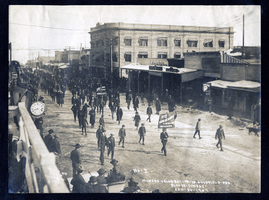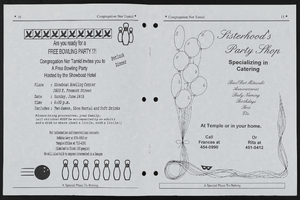Search the Special Collections and Archives Portal
Search Results

Photograph of the Miners Union Parade on 2nd Anniversary of Bloody Sunday Massacre in Russia, Goldfield (Nev.), January 20, 1907
Date
Archival Collection
Description
Caption: Miners celebration in Goldfield-Nev Bloody-Sunday Jan-20-1907
Image

Photograph fo Sunset Rooms boarding house, Goldfield (Nev.), circa 1906-1908
Date
Archival Collection
Description
Site Name: Sunset Rooms (Goldfield, Nev.)
Image

Photograph of a view looking east from Bonnie Claire Mill, Bonnie Claire (Nev.), early 1900s
Date
Archival Collection
Description
Image

Photograph of a mule team and wagon in front of Swan Bar, Goldfield (Nev.), early 1900s
Date
Archival Collection
Description
Site Name: Swan Bar (Goldfield, Nev.)
Image

Photograph of Dalta Hurry and C. A. Earle Rinker in Mohawk Ledge mine, Goldfield (Nev.), early 1900s
Date
Archival Collection
Description
Image
Ellen Burke Rawls Papers
Identifier
Abstract
The Ellen Burke Rawls Papers comprise the professional writings of Ellen Burke Rawls from 1987 to 1996. The papers document her work as a reviewer in the entertainment industry of Atlantic City, New Jersey and as a publicist for the other professional businesses in and around New Jersey. The material comprise of her personal correspondence, columns from a number of newspapers, correspondence of her participation in The Morning Show program and photographs that were used in her newspaper columns.
Archival Collection
John B. DuBois Papers
Identifier
Abstract
The John B. DuBois Papers (1967-2012) contain legislative bills, reviews, and requests from his time as a Nevada State Assemblyman from Clark County. Also included are newspaper clippings, campaign material, contribution letters, and election results. There are Datagraphic Research, Inc. Opinion Polls conducted and written by his wife Judith DuBois, photographs, speeches, and a manuscript for a stage play adopted from a novel written by John DuBois.
Archival Collection
Southern Nevada Women's Political Caucus Records
Identifier
Abstract
The Southern Nevada Women's Political Caucus Records (1981-1992) document a chapter of the National Women's Political Caucus. It was active in child care issues and in aiding women who aspired to be elected to public office. Included are chapter bylaws, minutes, newsletters, and information on local child care and the Act for Better Child Care Services of 1987. Also included are records of forums, conferences, dinners, newspaper advertisements, financial records, and membership information. There is national information, including a bumper sticker, and a poster.
Archival Collection

